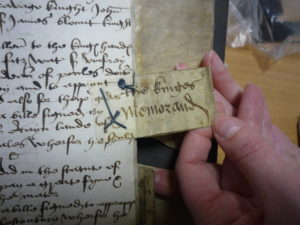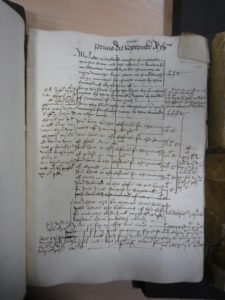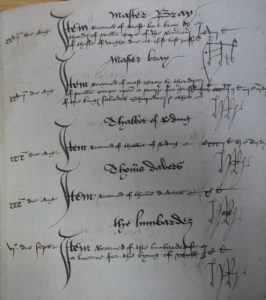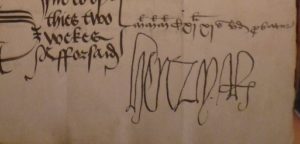Citations for this edition:
The Chamber Books of Henry VII and Henry VIII, 1485-1521, eds. M.M. Condon, S.P. Harper, L. Liddy, and S. Cunningham and J. Ross, www.tudorchamberbooks.org
Short form: Chamber Books of Henry VII and Henry VIII, eds. Condon, Harper, Liddy et al., www.tudorchamberbooks.org
To cite a specific quotation, folio or page, e.g. The Chamber Books of Henry VII and Henry VIII, 1485-1521, ed. M.M. Condon, S.P. Harper and L. Liddy, and S. Cunningham and J. Ross, TNA, E36/214, f. 81r, [INSERT SPECIFIC URL]
The Chamber
The Chamber was a department of the royal household concerned with the king’s most personal needs. It had also become under Edward IV (reigned 1461-70, 1471-83) the primary instrument of royal finance, as income streams were diverted into the Chamber from the more bureaucratic Exchequer, and a small number of personal servants handled the revenues of England under the eye of the king. This system was largely abandoned on Henry VII’s accession, but within a few years was revived and made more efficient, both through Henry VII’s close personal attention, and the longevity of one or two key officials, notably John Heron, under-treasurer of the Chamber from early in the reign and from 1492 the treasurer of the Chamber until 1521. It was his responsibility for keeping the accounts, now known as the chamber books, some of which are in his own handwriting, though he did manage a small number of clerks. This combination of direct personal service to the monarch and handling most of the crown’s revenue explains the incredible variety of entries in the Chamber Books, from small payments for strawberries to massive subsidies to foreign allies, as well as the financial instruments known as bonds and recognisances.
The Documents
This online edition of the Chamber Books of the early Tudor kings encompasses the content of all the extant Chamber Books from early in the reign of Henry VII to the end of John Heron’s tenure as Treasurer of the Chamber in 1521.
A total of nine payment books and three receipt books exist and have been transcribed in this edition, alongside an antiquarian abridged copy of the books made by Craven Ord (1756-1832), which contains some payments from a now missing payment book of the Chamber covering the dates 1491-1495, and continues to 1505. One slim volume of receipts and payments of Henry VII’s queen, Elizabeth of York, also survives. Most of these documents are held in The National Archives (TNA), with four, including Ord’s volume, held at the British Library (BL). Together they comprise nearly 4,500 pages of information that give a personal insight into the rulership, diplomatic engagement, rhythms of court life and pastimes of the first two Tudor kings.
The payment books average several hundred folios, with the front section detailing payments made out of the Chamber and the back section of the book containing miscellaneous information of interest to the king. In Henry VII’s payment books this miscellanea is frequently divided by tags sewn on to the pages, dividing the information into headings such as ‘Obligations, Recognisances, Tailes, Wards, Liveries and Memoranda’. All the books, including those of Henry VIII to 1521, once had such tags but they have been removed in the course of later rebinding in hard covers.

The books are as follows:
- TNA, E101/413/2/1 July 1487 – July 1489 Receipt Book
- TNA, E101/413/2/2 Sept 1489 – Oct 1495 Receipt Book
- TNA, E101/413/2/3 Oct 1502 – Oct 1505 Receipt Book
- BL, Add Ms. 7099 Oct 1492 – 1509 Antiquarian copy
- TNA, E101/414/6 Oct 1495 – Oct 1497 Payment Book
- TNA, E101/414/16 Oct 1497 – 1 Oct 1499 Payment Book
- TNA, E101/415/3 Oct 1499 – 1 Oct 1502 Payment Book
- TNA, E36/210 Mar 1502 – Mar 1503 The Queen’s Book
- BL, Add. Ms. 59899 Oct 1502 – Oct 1505 Payment Book
- BL, Add. Ms. 21480 Oct 1504 – Oct 1505 Payment Book
- TNA, E36/214 Oct 1505 – 1 May 1509 Payment Book
- TNA, E36/215 April 1509 – Oct 1518 Payment Book
- BL, Add. Ms. 21481 April 1509 – April 1518 Payment Book
- TNA, E36/216 April 1518 – April 1521 Payment Book
There is some duplication within the manuscripts. This is discussed in more detail in the analysis of the Chamber Books on this site.
Prior to this digital edition, only excerpts of the payment books have been published in S. Bentley’s Excerpta Historia (1831) which relied upon Ord’s heavily abridged copy of the Chamber Book payments. As is apparent from Ord’s copy of the extant Chamber books, he was not the most diligent of transcribers, and his payments are littered with misreadings, careless mistakes and dubious interpretations of the material. The books of payments from 1509 were abstracted in Letters and Papers, Foreign and Domestic, of the Reign of Henry VIII, ed. J.S. Brewer et al, 23 vols in 28 (London, 1862-1932). The queen’s book is the only one printed in its entirety in N.H. Nicolas, ed., Privy Purse Expenses of Elizabeth of York (1830) but there are omissions and a few errors within, probably as a result of the poor condition of the original document
Editorial method: Transcription
The editorial team have endeavoured to reproduce accurately not only what was on the page, but also reflect the intended sense of the writing. In both the Payments and back of book sections (which include Cofferer, Revenues, Debts, Recognisances, Obligations, Tallies, Wards, Liveries, Memoranda and Loans), the central text records the main entries, detailing the payment, debt, bond etc., with dates, names, graphics and sign manuals occasionally appearing in the left-hand margin. However the back of book sections have many more components, including numerous later additions detailing full and partial payments in both right and left margins. Occasionally these later notes also extend into the central portion of the text, beneath the entry to which they refer. The left margin can also contain groupings of related material (usually indicated using a bracket) and other changes to the terms (e.g. vacat), with later additions written increasingly further from the central text towards the outer edge of the page. Thus reproducing the layout of the original helps to facilitate the understanding of these various layers of contemporary annotation.

Whilst faithful reproduction of all pen-strokes is plainly impossible, we have reproduced as much as is possible, including marginal graphics, insertions, interlineations and deletions where they occur. All redacted words have been extended, though each editorial intervention is colour coded so that the reader is in no doubt as to where intervention has taken place. All marginalia has been reproduced and anchored to its relevant section of the central text. This was a particularly arduous task when transcribing the materials in the back of the Chamber Books, since, as mentioned above, these were working documents with (frequently overlapping) marginalia denoting payment increments, vacated entries, paid entries and other information such as in the above example from E101/415/3, f. 141r. These various layers of marginalia were each assigned a column to clarify their position and purpose; thus marginalia physically closest to the main text was tagged as column 1, the next layer column 2, and so on, in both left and right margins if applicable.
All extensions have been made in accordance with the conventions to be found within the document, so for example: Candle[mas] and Christ[mas] are given as Candel[mes] and Christ[mes]; Alex[ander] becomes Alex[aunder]; king[‘s] is king[es]; s[er]u[a]nt[s] is s[er]u[au]nt[es]; warr[aunt]; thenbassado[ur] or thenbass[adour] is used for the ambassador, and so on. Latin extensions, particularly in the quarterly audits of the Payments sections, have been treated in the same way, replicating the spelling and case most commonly used, whether grammatically correct or not. Abbreviated place names in both English and Latin received similar treatment. Thus counties whose names end in -shire, such as Yorkshire and Lincolnshire, become Yorks[hir] and Lincon[shir]; Oxfordshire is rendered as Oxen[ford] or Oxon[ford]; Windsor is Windeso[ur]; Cant[er]bury becomes Cant[ur]bury; Midd[lesex] is Midd[elsex]; and Hunt[ingdon], Buk[ingham] and Not[ingham] become Hunt[yngdon], Buk[yngham] and Not[yngham], for example. Where there is no established convention within the documents then the word has been extended in accordance with modern spelling.
The only change from the original text is with the consistent capitalisation of names, places, days of the weeks and months in this digital edition, which was not done consistently in the original. It is nearly impossible in many cases to decide whether a given letter was intended as a capital or not, particularly in the case of ‘M’,‘N’ and ‘D; and so the adoption of this methodology made it easier to maintain a level of consistency throughout the documents and to ensure that the meaning of the original was conveyed in the digital edition. This convention extends to feast days where the feast contains a name, such as Andrewtide or Michaelmes, but not to other feasts such as Easter. Titles such as ‘sir, lord’ etc., have been transcribed as lower case unless they were written with a capital in the original. Similarly, punctuation has been transcribed exactly as it appears in the original text and has not been modernised in any way, although it was often impossible to differentiate between an intended full stop and a pen rest. Double ‘f’, though it usually denotes an intended capital, has been transcribed exactly how it appears unless it prefaces a name, place or date in which case it has been represented as ‘F’.
Given that by the end of Henry VII’s reign there were at least two and perhaps three scribes working for John Heron, it is impossible to state with any certainty which folios were written by whom. However changes in scribal hand have been noted. Henry VII’s own handwriting, conversely, is rather distinctive and his occasional insertions and marginalia have been tagged accordingly. The sign-manuals of both Henry VII (whose differing signatures can be seen below in an example from 1492, E101/413/2/2, f. 36r ) and Henry VIII (which evolved over time, see examples from July 1509 and February 1511, Add Ms 21481, ff. 9r and 53r below) have also been noted.



Editorial Method: Tagging and Mark-up
At the beginning of the project, each Chamber Book was assigned to one of the three researchers, with each initially responsible for transcribing the Payments sections of their manuscripts. The first transcription of each was made from high-quality colour digital images, provided before or during the earliest stages of the project by the University of Bristol’s Cabot project, working from documents in The National Archives and by the British Library, which generously provided the Project with digital images in advance of their formal publication on the British Library Digitised Manuscripts website. Each folio was transcribed as a separate file and marked up in xml, using Oxygen XML editor, to allow for easy manipulation and searchability and, eventually, to enable the creation of a modernised text. The name of each xml file corresponds to each folio’s or page’s number and to the manuscript reference of the book to which it belongs (so, folio 1r of the earliest Receipt book = E101_413_2_1 001r.xml, folio 1v = E101_413_2_1 001v.xml, folio 2r = E101_413_2_1 002r.xml, and so forth). The various tags used to mark up the text evolved and were added to over time as new textual interventions and practices were discovered. The very different purpose and layout of the Receipt books, as well as the Queen’s book which contains both payments and receipts, required several new tags. Different again was Craven Ord’s abridged copy of the now-missing 1491-1495 Payments book, which was set up with his version of the original copied onto the right-hand page and his own notes on the facing page, with a symbol connecting the comment to its intended place in the main text. However the majority of new additions came when working with the material at the back of the Payment books, where entire entries, or even pages, could be deleted, vacated, or so heavily annotated that additional tags were required for clarity. Examples of new tags that were added at this stage include: ‘vertical cancellation’ to denote entire entries or pages that had been struck through; ‘sequence’, used within ‘marginalia’ tags to separate and differentiate between various partial payments made on different dates; and ‘anchor’ used to attach marginalia to the entry or entries to which it pertains.
When transcription of a Payments section was complete, another researcher then checked each file against the high-quality digital image for accuracy and consistency, referring to the original manuscript for clarity when required. After all necessary amendments had been made to the transcription and tagging, the files were again checked by a third member of the editorial team. This process was repeated for each Back of Book section which, given the complexity of the layout and accompanying annotations, was a time-consuming and often frustrating exercise. The result, however, is a digital text which hopefully resembles the original as closely as is possible. Throughout each book, and its component parts, a consistent mark-up policy was adhered to by all of the editors in both the metadata and transcription portions of the files
When the editorial team had completed the transcription and checking of the Chamber Books, the project’s partners at Sheffield HRI then applied modernisation algorithms to the text in order to generate a second version that has modern spellings. The algorithms use dictionaries, syntax and orthography rules as part of its decision-making process, as well as drawing on existing spelling regularisation tools such as VARD, and this was done over several iterations. Some editorial checking of the modernised was done by volunteers at the Universities of Sheffield (Hollie Mclhone) and Winchester (James Connelly and Abbie Gardiner), to whom the project is very grateful. Work on the modernised text is still ongoing and no automated modernised text can be 100% perfect.
Select bibliography on Editing Texts
For the beginner:
R. Hanna, Editing Medieval Texts: An Introduction, Using Exemplary Materials Derived from Richard Rolle, ‘Super Canticum’ 4 (Liverpool University Press, 2015)
The classics:
R.F. Hunnisett, Editing Records for Publication, Archive and the User. 4 (British Records Association, 1977)
P.D.A. Harvey, Editing Historical Records (British Library, 2001)
On digital editing:
A. Prescott, ‘The Imaging of Historical Documents’, in M. Greengrass and L.M. Hughes, eds, The Virtual Representation of the Past (Ashgate, 2008), pp 7-22
G. Vogeler, ‘The “assertive edition”: On the consequences of digital methods in scholarly editing for historians’, International Journal of Digital Humanities 1 (2019), pp. 309-22, https://doi.org/10.1007/s42803-019-00025-5
